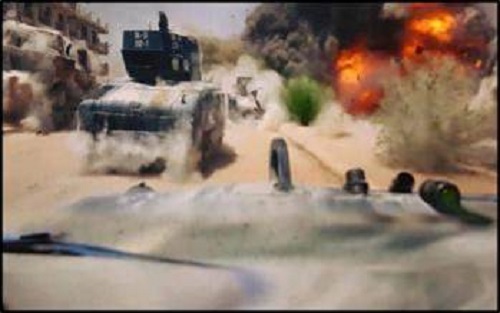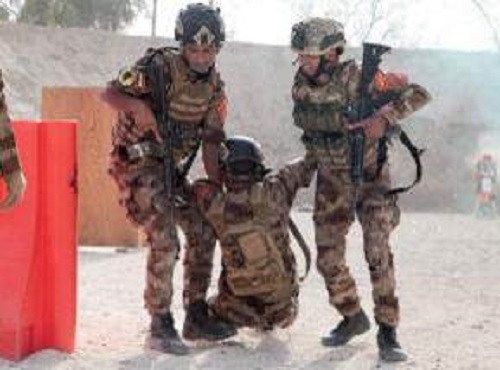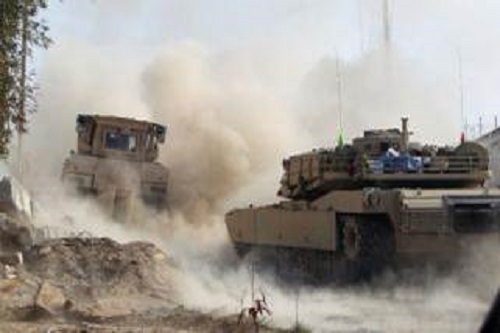Advise, Assist and Enable in Iraq: It’s a Human Thing
Matt Stevens
This article was originally published by The Cove and is republished here with their kind permission.
Over the fourteen months from September 2016 to November 2017, the Iraqi Security Forces (ISF) wrestled their nation from the clutches of the Islamic State (IS) in some of the fiercest and most brutal urban combat experienced since World War Two. In May 2017, the Australian Special Operations Task Group (SOTG) Rotation VII took over the great work of previous rotations in advising[1], assisting[2] and enabling (A2E) the Iraqi Counter Terrorism Service (CTS), our primary partners. In our preparation for deployment, we estimated that the Battle for Mosul would culminate within a few weeks of handover. Events would show how wrong that assessment was. The Battle for Mosul would endure for another three and a half months, with the population of the city of Mosul finally freed from the oppressive regime of IS, having endured immeasurable human suffering on a scale almost incomprehensible for most ordinary Australians. For the Iraqis, this was a war of necessity and they were determined to rid their nation of IS, but they needed our help.
The Mission
Our approach was simple; the mission was both about Iraq and for Iraq, and as a coalition our purpose was to provide crucial support to the Government of Iraq’s campaign against IS. Within the SOTG, the manner in which we provided A2E to CTS was largely based upon the human interaction with the Iraqis at all levels within CTS. This human interaction was as important as, or at times greater than, what we offered in purely transactional effects. From the beginning of the tour, our mindset was what mattered and was critical to the maintenance of the friendly force centre of gravity: our ability to positively support and influence CTS.
The Task Group’s focus was twofold; support the conduct of expeditionary operations (which remained the main effort throughout) and conduct operational generation (OPGEN) training of CTS. Both these tasks were predominantly based upon the 1st Iraqi Special Operations Forces Brigade (1 ISOF) and the various special missions units within.
Coalition expeditionary operations were conducted under the command of Task Force CTS (TF-CTS). As the Commanding Officer (CO), I commanded this TF, in addition to my remit commanding the Australian SOTG. TF-CTS consisted of a diverse coalition of Australian Commandos and a small number of Special Air Service (SAS) operators, US Naval Special Warfare operators, paratroopers from the US 82nd Airborne Division, and specialist surgeons and medical staff largely drawn from the US and Belgium. TF-CTS provided A2E effects to a 2,500 strong CTS force which was the vanguard for the ISF. During our tour we provided A2E effects throughout the clearances of the major population centres occupied by IS. These included Mosul, Tal Afar, Avghani, Hawija, and the Middle Euphrates River Valley out to Al Qaim bordering Syria. Our approach required agility and adaption as we supported CTS, who led the way for the ISF through decisive action, positive example and resolute leadership. CTS and the ISF had suffered significant casualties through the battles of East and West Mosul and the exhausting, close-quarter combat they endured was not lost on the coalition advisers, who demonstrated empathy as our partners excised the scourge of IS.

CTS on the advance through Mosul
Training Effects
In addition to supporting major clearance operations, the SOTG supported OPGEN training of 1 ISOF and the various CTS special missions units. The majority of this OPGEN training was conducted in an Iraqi training area in Baghdad. This training, which was conducted largely by Junior Non-Commissioned Officers (JNCOs) from within the Commando Company, was impressive. JNCOs planned, coordinated and executed up to Company level training in martial skills, including marksmanship, rural and urban manoeuvre, explosive and manual breaching techniques, and close quarter fighting. The training aperture was expanded to include a range of other non-martial skills which had a direct and tangible effect on the outcomes of major clearance operations, including plant operation (armoured bulldozer and front-end loader), communications, intelligence analysis, operations planning, logistics (including deep maintenance and refit), combat engineering, counter-improvised explosive device procedures, and demolition of malfunctioned explosive ordnance training.
This balance of kinetic and non-kinetic skills transferred directly to the battlefield increased CTS’ capacity and capability to defeat IS. The training also served to increase CTS’ survivability, preserving them as the elite fighting element of the Iraqi military. The OPGEN training further reinforced the SOTG approach and Australia’s commitment to the people of Iraq. The multitude of personal relationships established and enhanced across the various elements of CTS during the OPGEN training served to strengthen mutual trust and, like the main effort support to expeditionary operations, provided another layer of force protection to our soldiers operating outside the confines of a forward operating base or Baghdad.
To enable positive, balanced and harmonious relations you need the right people. As a Task Group we were blessed with intelligent personnel, both emotionally and intellectually. It was a mixed group of Special Forces (SF) qualified, Special Forces Support Staff (SFSS) and various specialists from across the Australian Defence Organisation (ADO). Most leaders had previously experienced combat command and had prepared their teams in a very deliberate and measured manner in accordance with the likely demands of the mission. The leadership at all levels understood what was important to the mission and were empowered to discard the distractions. There was no point arriving tired, and I offer that one of the tenets of our success was the ability to maintain a reserve of combat capability in case it was needed. This included a realistic battle rhythm that could be endured for the seven and half month tour; a manageable rest cycle including relief out of country leave, battlefield circulation for all members of the Task Group, daily physical training, adequate diet (not always achieved!) and the enhancement of relations with our partner force through cultural and social interactions.

1st ISOF Brigade elements in force generation training
Expectation management was a key theme throughout the rotation. In the National interest, we were there for one reason – to support the Government of Iraq win their fight against IS. This was not Afghanistan. The mission, while including the provision of precision kinetic effects, did not involve Australian ‘boots on the ground’ in direct action or combat operations akin to the Australian SOTG / Task Force (TF) 66 mission of 2007 to 2013 in Afghanistan. What the mission did require were the ‘softer’ skills of shaping and influencing, utilising tact, intuition and judgement. These skills and attributes are not a given; nor are they prolific throughout Army or indeed the wider Australian Defence Force (ADF). Deliberate selection of suitable personnel is required to deliver the intended effect. However, when coupled with the Army’s core values and inherent training methodologies, these human aspects of capability proved very effective. This approach, teamed with sound leadership and a mission command philosophy based upon trust and mutual understanding, reinforced the successful support to our partner force.
Influence Effects
Relationships are everything. The SOTG mindset supported the development and enhancement of enduring relationships at all levels with our Iraqi partners. The importance of our mission in Iraq was clearly perceived by all members of the SOTG and I contend that as Australians, we genuinely had no ulterior motive or agenda, other than helping the Iraqis rid their country of IS. It was a noble cause. The A2E mission spanned all levels of command within CTS. As the CO, I advised the operational commander of CTS, Staff Lieutenant General (sLTG) Abdul Ghani; a Shia veteran of the Iraq Army, having served as an Armoured Corps Officer since commissioning in 1974. He is a proud Iraqi who has fought in every war since 1974, including twice previously against the US / Coalition. He intimately understood sacrifice and has seen the immense suffering of the Iraqi people under the ideological, fanatical and irreconcilable rule of IS. He was a very demanding man, with unprecedented influence and access at all levels of the Iraqi Government. He liked Australians and commanded respect from all. My approach to advising sLTG Ghani was to listen foremost, offer tangible support, and only provide discreet tactical and operational suggestions. After all, there was only so much ‘mentoring’ of a veteran general officer one could offer in this context within the Iraqi military. He knew more about manoeuvre warfare than any of us within the SOTG or TF-CTS. Recognising and acknowledging this was fundamental to our approach. He didn’t need me to be there with him 24/7.
The CTS commander and I met at least daily, sometimes a few times a day. I would move forward to his Division Headquarters (HQ) throughout the battle for Mosul and, like the work the Commandos were doing forward at the Brigade level tactical HQ, provide increased situational awareness to enhance command and control and enable the judicious application of coalition precision fires and effects. Standing next to them on a tough day meant more than just the provision of a merely transactional effect.
On occasions, when we were planning future operations as a coalition, it became apparent that the Iraqis had not been consulted. As a result, these operations were rarely executed in a coherent or timely manner. We learnt early that engagement with the Iraqis was vital. Their buy-in, ownership, consideration and advice made the conduct of operations tenable and successful. A lot can be achieved over a cup of chai tea. They immensely respected Australia’s support which was without favour or bias.

The CTS micro-combined arms team; D7 Armoured Bulldozer with an M1 Tank
You cannot surge trust. The SOTG approach developed immense trust with our Iraqi partners. Mutual respect and shared experience did provide us with a superior level of access, influence and understanding, despite not being engaged with them in close combat. The level of trust conferred us was another level of force protection, particularly during the occupation of Tactical Assembly Areas (TAA) in relatively remote and isolated locations within a high threat environment. This mitigated risk significantly. Mutual respect is of course not just an ingredient of successful partner relations; it is fundamental to an inclusive, collaborative and highly functioning task group. The age-old adage of ‘treat people as you like to be treated yourself’ goes a long way to achieving the best out of your people and partners, and ultimately mission success.
Tactical Effects
The effects generated at the tactical level within the expeditionary elements of the TF were a combat multiplier. Joint Terminal Attack Controllers (JTAC), usually JNCOs, provided timely and accurate precision fires whilst often immersed in a chaotic and unpredictable environment, be that within the Fires Cell at a TAA or forward within either the Brigade or Division tactical HQ. Platoon Commanders and Platoon Sergeants engaged daily with star ranked Iraqi officers, often in the heat of major clearance operations, to provide tactful advice and sage counsel. Humility, empathy and patience were virtues vital to our successful interaction and support to our partner force. Developing and enhancing these skills is critical for Army. Consideration to include such elements in the officer and soldier all-corps training continuum is worth exploring. There was immense pressure placed on the junior leadership during these operations, particularly when CTS was suffering attrition and bogged down mid-clearance in complex urban terrain. CTS’ ‘thirst’ for kinetic effects was insatiable.
The value of a senior soldier, such as the Regimental Sergeant Major (RSM), providing experienced and measured oversight and leadership in this type of threat environment, was invaluable. The RSM would provide calm and measured influence, as well as another protective and filtering layer on the emotional and consistent demands asked of the JTACs by our partner force. In addition to this function, the RSM was able to ensure a baseline of multi-layered force protection in the expeditionary or TAA location. This included careful interactions with both the Iraqis and the leadership of the Paratroopers from the 82nd Airborne Division providing our local security – vital to the necessary force protection in such vulnerable locations. In one instance, there was an internally displaced personnel camp 300m across from the entrance of a TAA, full with over 3,000 people escaping the conflict in Mosul.
The work of the surgeons and medical staff operating from the Casualty Collection Point within the TAAs was relentless and demanding. The leadership of this disparate group of US and Belgium medical staff personnel fell to the sole Australian Medic in location, an Army JNCO. Over a four-month period he oversaw the triage and treatment of hundreds of combat casualties, including a number of French civilian journalists caught up in the Mosul fighting. His ability to remain focused, lead and influence under such incredible demanding pressure speaks volumes for the Australian Army’s training system and how it prepares our soldiers for operations. This medical support, that saved hundreds of Iraqi lives, also served the Task Group well with mutual respect and sincere gratitude from our Iraqi partners. Future A2E missions should include a robust medical capability for the benefit of the partner force and the deployed force element.
Conclusion
The effects achieved in supporting CTS and the people of Iraq in the military defeat of IS were enormous. How we supported them mattered more than what we did. The SOTG 632 approach hinged on our ability to maintain and enhance human relations at all levels. Solid relationships, grounded firmly in trust and mutual respect, kept everyone oriented on the mission, particularly on the days when things were tough and tiring, such as the final stages of the clearance of the Old City of Mosul. Building the right team, focusing on priorities, discarding distractions and employing a genuine mission command leadership philosophy is the keystone to successful A2E operations and exists as an evolved model for consideration in Army’s future operating concept discourse.
End Notes
[1] Advise – activities that include facilitating and influencing by means of counsel and dialogue. The improvement of forces through the creation of a professional relationship based upon trust. This also includes observation, evaluation and performance reporting to focus effort and asset apportionment.
[2] Assist – activities include the provision of direct and indirect enabler support to enhance planning and the conduct of operations. This also includes the facilitation of coalition capabilities with defined authorities and limitations, such as precision fires, releasable intelligence and combat casualty care.
